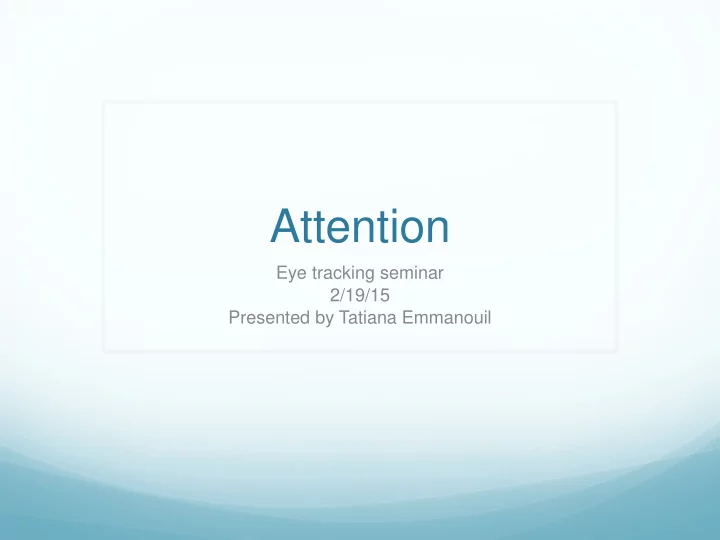

Attention Eye tracking seminar 2/19/15 Presented by Tatiana Emmanouil
Outline • What is attention? • How is attention allocated? • How are eye movements related to attention? • Further questions
Attention • Attention highlights relevant sensory information. • Attention has a limited capacity
How is attention allocated? • We can direct attention to information that is relevant for our goals top-down attention
How is attention allocated? • We can direct attention to serve our behavioral goals top-down attention • Attention is often captured by salient stimuli in the environment bottom-up attention
How is attention allocated? • We can direct attention to serve our behavioral goals top-down attention • Attention is often captured by salient stimuli in the environment bottom-up attention
Top-down vs bottom-up attention Top-down: Stored stored representations representations, modify the priorities given to expectations different stimuli priors Sensory Bottom-up processing Stimulus “hijacks” the system based on its features
Separate attention networks Top-down attention: Dorsal network Bottom-up attention Ventral network
Interaction between top-down and bottom-up attention • Salience maps contain a map of locations that are differentially activated depending on both bottom-up salience and top-down goals
Attention and eye movements • Attention and eye movements are naturally linked • However attention can shift without an eye movement • Attention with eye movements = overt attention • Attention without eye movements = covert attention
Attention and eye movements • The neural networks that support attentional shifts and eye movements overlap (Corbetta et al., 1998) • Premotor theory of attention (Rizolatti et al., 1987): A shift of attention is a planned eye movement
Attention and eye movements • A large body of research investigates covert shifts of attention. • In these experiments participants are asked to attend while maintaining central fixation. McMains et al., 2007
Covert attention can be studied! Valid target Cue Interval * Invalid target * * * • Reaction times are faster for targets that appear in attended compared to unattended locations.
Further questions • Does attention highlight locations in space or entire objects? • In what ways does attention “enhance” the processing of information? • What happens to information that we do not attend to? • Are there some types of objects or scenes that require less attention to be perceived?
What happens when we do not attend? https://www.youtube.com/watch?v=FWSxSQsspiQ
Recommend
More recommend